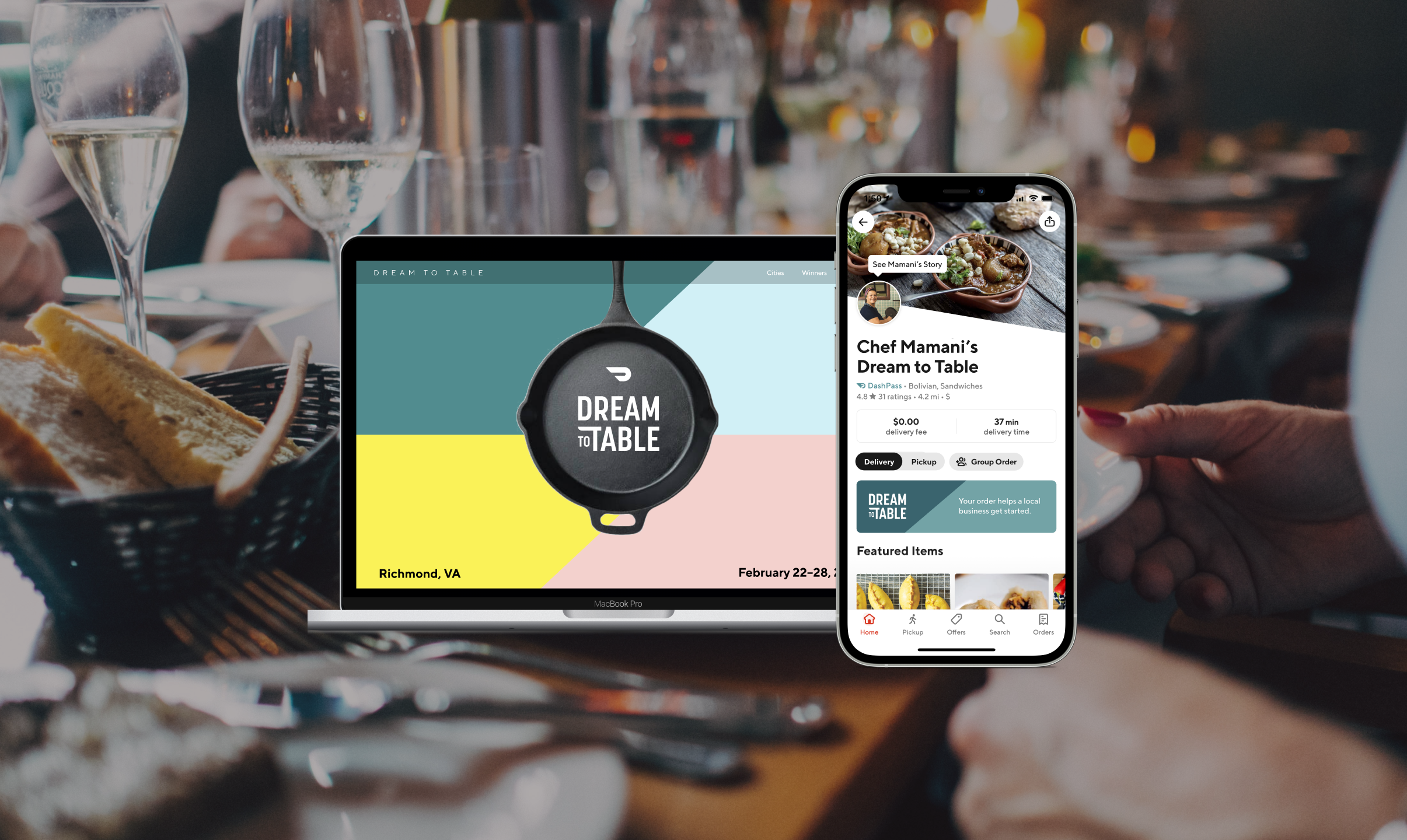ROLE
Strategist
Brand Research
Product Thinking
User Testing
Door Dash: Dream to Table
Dream to Table is a business accelerator and local food competition that leverages DoorDash's digital and physical assets to help aspiring restaurant owners open businesses in their community.
TEAM
Curtis Winiesdorffer
Sharon Byun
Emily Riggan
TYPE & TIMELINE
Live Client Competition (BC Sprint)
1 week
TOOLS
Figma
Illustrator
Current Landscape
BIPOC who aspire to own a restaurant face long-standing inequities, especially in comparison to their white counterparts.
Most entrepreneurs start their businesses using personal or family wealth. But the a study finds that Black entrepreneurs are more likely to rely on personal credit cards to finance their business creation.
Problem
Kitchen inequality exists in the food industry.
Not every cuisine or cultural group has an opportunity in every city.
Context
1 Week. Live Client. Competition.
Our team took part in a week-long design sprint for DoorDash and the Martin A, where we explored new ways that the company could support the push for social progress.
Opportunity
DoorDash can leverage its brand and platform to empower aspiring and up-in-coming chefs.
DoorDash can commit to sharing their physical and digital real estate with underrepresented groups.
Solution
Social Progress, Local Entrepreneurship, Ghost Kitchens, Quality Food.
Foster local entrepreneurship and welcome new businesses by engaging the community.

How it works
Building community and competition into the DoorDash mobile app
Our primary challenge, beyond developing the competition structure, was determining how to integrate the Dream to Table user experience with the existing app design. On one hand, we wanted to break the script enough to draw attention to the new feature. But we also wanted to provide the same seamless experience users have come to expect
IN-APP MARKETING
Balancing convenience and context
Ordering with DoorDash is a habitual act for many people. We wanted to break the script through visible but unobtrusive tactics.
On-load alerts and a new icon in the top navigation to entice customers to explore Dream to Table restaurants. The icon filter could be repurposed to a more general "Local" filter after the competition ends.
2. B2C PERSONALIZATION
Restaurant photos add a personal touch
DoorDash allows local restaurants to reach more people, but that extended network comes at the cost of less face-to-face interaction with customers.
Since personality is often a local restaurant's biggest selling point, we made sure to feature photos of the competing chefs.
3. COMMUNICATION STRATEGY
Chef videos give people a peek behind the scenes
In addition to missing out on the personal touch of a local eatery, DoorDash customers don't get a chance to feel or compare the particular ambiance of each place.
New profile videos, accessed by tapping the restaurant thumbnail, allow customers to learn more about the cultures and cuisines within their community.
4. COMPETITION DASHBOARD
Customers can track the competition in the app
Dream to Table design elements to the existing restaurant thumbnails and restaurant pages to make them stand out.
5. REWARDS
Earn promotions for supporting local businesses
Since each order counts as a point, customers can easily see their impact on the competition score. Repeated orders during the competition also earn them valued promotions like free delivery.
Design Process
Designing on a sprint deadline
Before diving into ideation and coming up with solutions, our team took time to assess the problem, survey the industry and consumer landscape, and identify the most impactful areas to focus our energy during the short time period.
User Feedback
Users said the Dream to Table experience felt on-brand for DoorDash and made them excited to order.
We tested the new app experience with several users familiar with Door Dash and delivery apps. Our research goals were to gauge user understanding of the Dream to Table concept as presented in the app experience, and to address any unwanted friction points we may have introduced into the ordering process.
A majority of users understood the concept through the combination of informational alerts and new design elements (e.g. banners, icons). A few expressed interest to learn even more about the competing chefs. In an effort not to clutter the app, we will rely on the marketing through various social media channels to support and tell the story and create awareness for users.
The Results
2nd Place BC Sprint 2021 Finalist.
Awarded some cash.
Bragging rights
Reflections
Working with an all-XD team was really refreshing and illuminating through out the whole sprint process.
Proper research and user testing is difficult to achieve with a short timeline. That said, massive platforms like DoorDash create feedback loops across many channels, so we learned a lot about how to reach insights using quick-and-dirty research tactics.
Considering “invisible” moments of the user experience — what happens before or after the customer orders their food — drove home the importance of thinking beyond the interface to the moving pieces behind DoorDash's entire service design model.
Other Projects


















